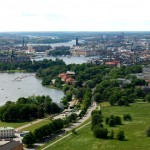STOCKHOLM – THE CAPITAL OF SWEDEN
Stockholm is the biggest city in Sweden and Scandinavia, the capital of the kingdom of Sweden. It is located on the eastern coast of the Melaren Lake. In Stockholm there is the main residence of the Swedish king, Arlando international airport; the Swedish government and Riksdag preside here. From the XIII century, Stockholm has been the biggest economical center of the country. Today it is the biggest Swedish city. Historically, this territory was very important for Sweden. The city was built on 14 small islands separate from one another, from which ships could be blocked from entering the lake of Melaren. The first part of the name – “stock” – means “log”, while the second – “holm” – means a “small island.”
In 1187, on this site of a fishermen’s settlement a fortified point began to be built. The first constructions were started on the island Stadsholmen located very comfortably strategically at the mouth of the strait joining the Melaren Lake with the Baltic Sea. The first mention of Stockholm as a city dates back to 1252. It is believed that it was founded by Rikscount Birger Yarl – a would-be king and originator of the Folkung Dynasty.
As early as by the end of XIII century, Stockholm began to enlarge from the old city to the North and South; and it was built according to a well-devised plan.
Booming development of trade with Dantzig and Lubeck and becoming a member of Hansa led to a great influx of Germans; and creation of the Kalmarsque union – to an influx of Danes. In XIV-XV centuries, Germans made up a fourth part of Stockholm’s population and a half of the Magistrate. Only after 1471, the Swedes were able to regain the key positions of the city’s management; and after release from the Danish dominion in 1523 it began to rapidly develop as the national, economical and political center of Sweden. Officially Stockholm was announced capital in 1634, and no other city during the future history of the country claimed over its preeminence.
In the beginning of XVII century, a Russian colony of merchants appeared in Stockholm. It happened after Sweden’s victory over Russia in a war when in 1617 according to a peace treaty Russia lost Eastern Karelia and Ingermanland and lost access to the Baltic Sea. Russian merchants were allowed to have trade courts in the capital and other seashore cities, to build homes and churches.
The city quickly grew but fires many times destroyed its wooden constructions; in 1697, even the king’s palace burned down. In the beginning of XVIII century, a severe plague befell the city and took lives of one third of its population.
In 1848, during the period of revolutions in Europe in Stockholm revolutionary uprisings also took place.
In 1860s, as a result of a railway construction the city was connected to the inner districts of Sweden, developed industrially and was partially rebuilt. In 1862, the Magistrate that existed since medieval times was abolished, which allowed to centralize communal administration of different parts of the city and unified them.
The capital of the country announced its neutral status since 1814 and was many times the venue for international assemblies, meetings and forums. In 1906, IV Unified RSDRP Council worked here. In 1912, Olympic Games took place in Stockholm. In 1950, a session of the regular committee of the worldwide Congress of supporters of peace passed a declaration here to ban nuclear weapons. Stockholm was chosen cultural capital of Europe in 1998.
Gamla Stan (the Old City) is one of the biggest and most protected medieval central parts of European cities and is the most interesting place of note in Stockholm. Here in 1252 Stockholm was founded.
The entire Gamla Stan and the Riddarholmen Island are operating museums of their own kind, full of places of note, attractions, restaurants, cafes, bars and shops. Gamla Stan is popular among folk lore craftsmen, collectors of ancient utensils and sellers of souvenirs. Narrow, winding cobblestone lanes framed with medieval houses characterized by different nuances of the yellow color accents make Gamla Stan unique. Behind the facades even nowadays underground storages and murals of the Middle Ages can be found. And in the snowing winter days this part of town looks like a picture from a book of fairy tales.
In Gamla Stan there are several beautiful churches and museums. Here you will find the national Cathedral Storkyrkan and Noblemuseet (Noble’s Museum). The biggest place of interest in this part of town is the King’s palace – one of the biggest palaces in the world with its more than 600 rooms. Beside the facilities to receive delegations, there are several interesting museums in the palace, among which there’s the Armory (Livrustkammaren), that exhibits King’s garments and arms. Do not miss the parade of the military orchestra and daily change of the sentries at the palace.
Pages: 1 2

